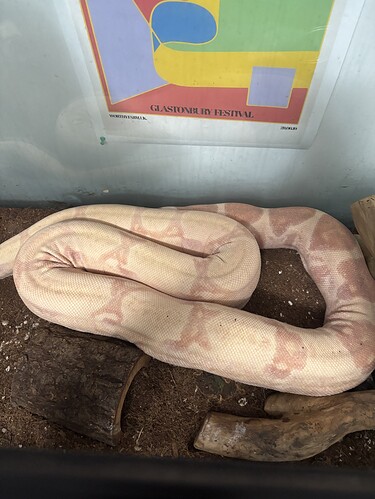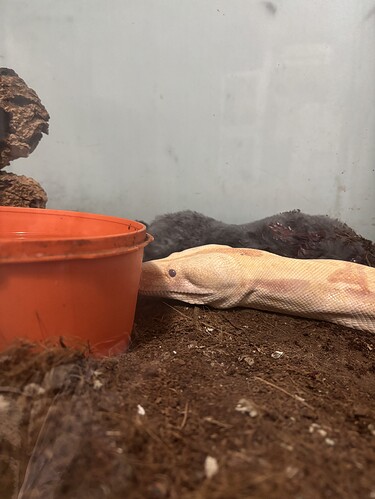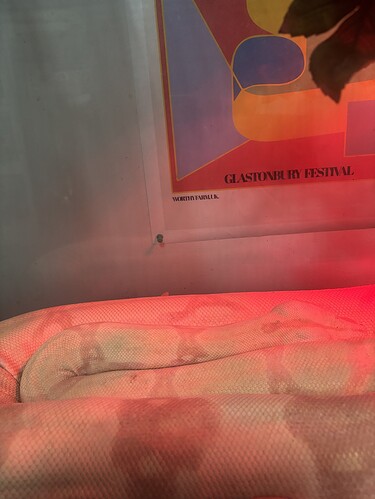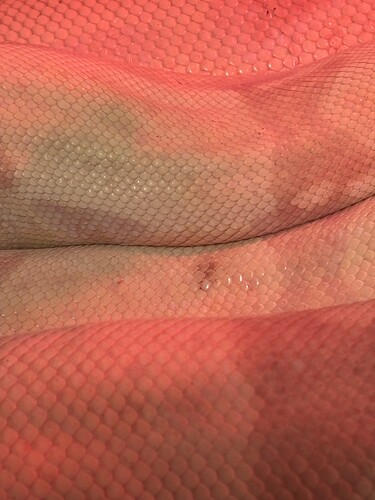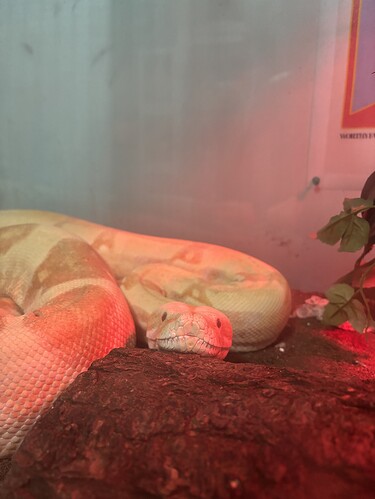Hi everybody! Just stumbled across this page today while trying to research what could be going on with my boa. She is a sunglow albino, I rescued her approximately 3 years ago, she’s about 13-14yrs old now and about 6ft long.
A few months ago I noticed some weight loss, I wasn’t able to find her usual size prey so I had to opt for the next size down and resorted to feeding her more often to compensate.
This week I noticed some changes in her behaviour, it started with a whistle/wheezing noise during her breathing which has now gone away (this has happened in the past but always after a shed, so I assumed stuck shed. This time was random, no recent shed) She seems tired and slower, but she still has an appetite as she just ate Saturday night. Her colour seems to be duller, her eyes looked cloudy (which I know can be the start to a shed) but I’ve noticed a spot on her back causing some concern to me. Her eyes have come back a little bit since initially noticing. I will attach pics of everything I can.
I will be calling all the vets local to me to see who is willing to look at her and the soonest I can get her in.
Thank you in advance for any tips or advice!
Image 1: Rosie on July 13
Image 2 & 3: Rosie Saturday night, dull scales and cloudy eyes
Image 4 & 5: Spot noticed on Rosie’s back
IMG_7022|375x499
1 Like
my first photo didn’t upload, this is her July 13th only about a week ago
2 Likes
A trip to the vet for sure.
As we age there are , unfortunately, a bunch of stuff that will slow us down.
First, respiratory issues. Definitely worth having that checked out. An ri can be sudden or can take weeks to become an issue. It could be as simple as a tiny piece of substrate stuck somewhere or a mis-shaped scale to a cyst or tumor. Could be related to humidity or an unseen/felt draft from a window/door/air con or even dust. It could also be related to obesity. Or parasites.
Second, the spot in the pic could be septicemia but that, I think, would start around a wound or a puncture and is usually caused by a dirty environment. I could be wrong. It could just be pigment. Or a fungal infection. Or a couple scales that are stuck from an old shed. Or something that transfered from being handled. I once had a gopher snake with a small tumor that turned out to be a mouse turd stuck on her scales. 
Considering her age and that you mention that she seems to be slowing down and is weak I would be concerned about cancer. Yikes!
However, you say she still eats. That is a positive. Has her food source changed? Do the prey items offered seem healthy? Whether f/t or fresh, do you know how they are raised and what their diet is? Or her water source? How are her bowel movements? Is there something in the environment that could cause these symptoms? I.e. cleaning supplies or even household “odor eliminating” sprays? Some types of wood can cause issues like mold or possibly leaching toxic resin. Even safe types can have an impact as they degrade.
Analyze everything. Food, water, exposure to other pets, people, air quality (temp, humidity, pollution), substrate, decor.
There are so many variables that I think the best piece of advice any of us can/ will give is to see a vet.
7 Likes
I agree with @gabonica1
There’s so many variables and there’s only so much we can suggest. But the snake seeming weaker and lethargic with weight loss is a big  for me. Especially if they’re still eating.
for me. Especially if they’re still eating.
I also don’t think that spot on the back seems too suspicious with everything else going on, but definitely bring it up when she goes in. It may be an isolated bacterial or fungal infection that took hold because of the weakened immune system.
Septicemia will usually be most visible on the stomachs of most snakes before the other areas, and sometimes a snake ‘in blue’ will have such a pink belly it can look similar. I don’t really have experience with boas, but from what I have seen the skin is definitely more prone to showing a systemic infection than pythons. Usually more than one spot will start showing the irritation and redness, which is thankfully much easier to see on lighter colored animals.
Regardless, it’s great that you’re taking such a great watch over her. Definitely would get her seen but do keep us updated!
Edit: had to go grab the link. This is definitely a great resource to check with as well.
Association of Reptile and Amphibian Veterinarians https://share.google/Viyuo9mrs3lKBGRPA
